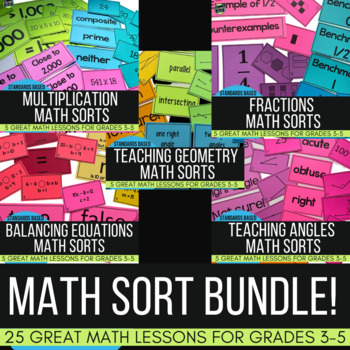Math Sorts - 25 Math Lessons to Improve Math Talk & Find Math Misconceptions
- Zip
What educators are saying
Products in this Bundle (5)
Description
Are you familiar with math sorts? Are you interested in helping your students address math misconceptions, develop their deep math understanding and grow their "math talk"? These ready-to-print, low ink lessons are perfect to reach all the math practice standards!
New to math sorts? Full directions and suggestions for use are included complete with photos!
Many people use "sorts" with their spelling or word work programs, but sorting and categorizing can be extremely effective learning strategies for MANY areas! I have found math sorts to be particularly effective in my math instruction, and I am excited to begin offering some of these sorts to you!
If you are unfamiliar with how sorts are used, I have included a full blog post with details. This blog post has actual photos that explain EXACTLY how I completed a sort with my own students. Feel free to get creative and try different approaches—but I have given one highly effective and efficient way to do this. It's like professional development at your fingertips!
My students have become masters at critiquing reasoning and using sophisticated math talk as they discuss these sorts--and I have had COUNTLESS teachers tell me that they have used these sorts for their evaluations and have had administrators rave. Why?
Because they are engaging for students while promoting best practices in math instruction!
If you've never used sorts before, I am confident that the series of photos and detailed instructions will get you started--but then get creative and use them in other ways as you see fit.
Each sort also comes with a reproducible page on the topic which can be used as homework, a cooperative activity, or even an assessment. See what you think--this resource has prompted teachers to contact me saying how impressed their administrators were when they used it for an observation lesson--good instruction leads to good things!
Each of the 5 resources is listed separately below--but this bundle offers them all together at a greatly reduced price! That makes 25 total sorts.
------------------------------------------------------------------------------------
So what concepts are covered in this bundle?
------------------------------------------------------------------------------------
What do you get?
- The blog post with full directions
- The necessary headers and sort cards for each of the 25 sorts
- A “Show What You Know” sheet that follows the rule of each sort. Use as independent practice or as an assessment after you have done a sort to see what the students know and what they still need to learn. Many of these also ask students to explain their thinking—a key part of the CCSS,
- Also included with each sort is a page of blank cards if you wish to extend the learning by having students create MORE examples that go in each category. This is a great way to differentiate for more capable learners! See each sort for other differentiation hints!
Hey--there's no answer key! Why? The important part about doing these sorts is the discussion rather than making sure every answer is instantly correct. Let the students discuss, prove their ideas, and develop understanding!
*A CCSS alignment sheet to show how these sorts align to the grades 4-5 CCSS. These sorts also tie to other sets of rigorous standards.
---------------------------------------------------------------------------------------------------
What are people saying?
"Excellent resource. I used the 'half', 'not half' sort yesterday and it turned out to be one of my best lessons of the year! We spent an hour and 20 minutes on it and the kids were engaged the entire time!"
"Doing a concept sort is a great way to engage and differentiate instruction for every student.....A great way to engage, differentiate, and evaluate!! I have other sorts from you...so as soon as I saw on Facebook that you had another sort prepared for distribution...I wanted to be the first to grab it. Thank you for improving my instruction."
"I used the line/segment sort as a preview to our geometry unit. This was a very challenging activity for my students. It required close attention to detail. It was great to see how many of them could persevere through this challenge. We will be trying the triangle sort next. Thanks for another great resource."
I hope you find the resource thorough, relevant, and engaging--and that it will push your students to increase the depth of their understanding and their mathematical practices as well.
------------------------------------------------------------------------------------
All rights reserved by ©The Teacher Studio. Purchase of this resource entitles the purchaser the right to reproduce the pages in limited quantities for single classroom use only. Duplication for an entire school, an entire school system, or commercial purposes is strictly forbidden without written permission from the author at fourthgradestudio@gmail.com. Additional licenses are available at a reduced price.





